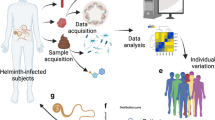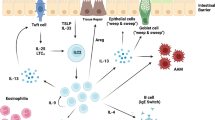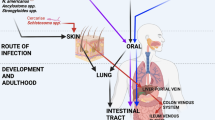Abstract
Helminths may protect humans against allergic and autoimmune diseases and, indeed, defined helminth-derived products have recently been shown to prevent the development of such inflammatory diseases in mouse models. Here, we propose that helminth-derived products not only have therapeutic potential but can also be used as unique tools for defining key molecular events in the induction of an anti-inflammatory response and, therefore, for defining new therapeutic targets.
This is a preview of subscription content, access via your institution
Access options
Subscribe to this journal
Receive 12 print issues and online access
$209.00 per year
only $17.42 per issue
Buy this article
- Purchase on Springer Link
- Instant access to full article PDF
Prices may be subject to local taxes which are calculated during checkout


Similar content being viewed by others
References
de Silva, N. R. et al. Soil-transmitted helminth infections: updating the global picture. Trends Parasitol. 19, 547–551 (2003).
Ruyssers, N. E. et al. Worms and the treatment of inflammatory bowel disease: are molecules the answer? Clin. Dev. Immunol. 2008, 567314–567320 (2008).
Cooper, P. J. Interactions between helminth parasites and allergy. Curr. Opin. Allergy Clin. Immunol. 9, 29–37 (2009).
van Riet, E., Hartgers, F. C. & Yazdanbakhsh, M. Chronic helminth infections induce immunomodulation: consequences and mechanisms. Immunobiology 212, 475–490 (2007).
Maizels, R. M. Infections and allergy — helminths, hygiene and host immune regulation. Curr. Opin. Immunol. 17, 656–661 (2005).
Carvalho, L. et al. Review series on helminths, immune modulation and the hygiene hypothesis: mechanisms underlying helminth modulation of dendritic cell function. Immunology 126, 28–34 (2009).
Anthony, R. M., Rutitzky, L. I., Urban, J. F. Jr, Stadecker, M. J. & Gause, W. C. Protective immune mechanisms in helminth infection. Nature Rev. Immunol. 7, 975–987 (2007).
David, T., Thomas, C., Zaccone, P., Dunne, D. W. & Cooke, A. The impact of infection on the incidence of autoimmune disease. Curr. Top. Med. Chem. 4, 521–529 (2004).
Cooke, A. Review series on helminths, immune modulation and the hygiene hypothesis: how might infection modulate the onset of type 1 diabetes? Immunology 126, 12–17 (2009).
Harnett, W. & Harnett, M. M. Therapeutic immunomodulators from nematode parasites. Expert Rev. Mol. Med. 10, e18 (2008).
Fallon, P. G. & Mangan, N. E. Suppression of TH2-type allergic reactions by helminth infection. Nature Rev. Immunol. 7, 220–230 (2007).
Helmby, H. Helminths and our immune system: friend or foe? Parasitol. Int. 58, 121–127 (2009).
Erb, K. J. Can helminths or helminth-derived products be used in humans to prevent or treat allergic diseases? Trends Immunol. 30, 75–82 (2009).
Elliott, D. E., Summers, R. W. & Weinstock, J. V. Helminths as governors of immune-mediated inflammation. Int. J. Parasitol. 37, 457–464 (2007).
van der Kleij, D. et al. A novel host-parasite lipid cross-talk. Schistosomal lyso-phosphatidylserine activates Toll-like receptor 2 and affects immune polarization. J. Biol. Chem. 277, 48122–48129 (2002).
Harn, D. A., McDonald, J., Atochina, O. & Da'dara, A. A. Modulation of host immune responses by helminth glycans. Immunol. Rev. 230, 247–257 (2009).
Aksoy, E. et al. Double-stranded RNAs from the helminth parasite Schistosoma activate TLR3 in dendritic cells. J. Biol. Chem. 280, 277–283 (2005).
Vanhoutte, F. et al. Toll-like receptor (TLR)2 and TLR3 sensing is required for dendritic cell activation, but dispensable to control Schistosoma mansoni infection and pathology. Microbes Infect. 9, 1606–1613 (2007).
van Riet, E. et al. Combined TLR2 and TLR4 ligation in the context of bacterial or helminth extracts in human monocyte derived dendritic cells: molecular correlates for Th1/Th2 polarization. BMC Immunol. 10, 9 (2009).
Goodridge, H. S. et al. Immunomodulation via novel use of TLR4 by the filarial nematode phosphorylcholine-containing secreted product, ES-62. J. Immunol. 174, 284–293 (2005).
Melendez, A. J. et al. Inhibition of FcɛRI-mediated mast cell responses by ES-62, a product of parasitic filarial nematodes. Nature Med. 13, 1375–1381 (2007).
Donnelly, S. et al. Helminth 2-Cys peroxiredoxin drives Th2 responses through a mechanism involving alternatively activated macrophages. FASEB J. 22, 4022–4032 (2008).
Atochina, O. & Harn, D. Prevention of psoriasis-like lesions development in fsn/fsn mice by helminth glycans. Exp. Dermatol. 15, 461–468 (2006).
Thomas, P. G. et al. Maturation of dendritic cell 2 phenotype by a helminth glycan uses a Toll-like receptor 4-dependent mechanism. J. Immunol. 171, 5837–5841 (2003).
Van Liempt, E. et al. Molecular basis of the differences in binding properties of the highly related C-type lectins DC-SIGN and L-SIGN to Lewis X trisaccharide and Schistosoma mansoni egg antigens. J. Biol. Chem. 279, 33161–33167 (2004).
van Liempt, E. et al. Schistosoma mansoni soluble egg antigens are internalized by human dendritic cells through multiple C-type lectins and suppress TLR-induced dendritic cell activation. Mol. Immunol. 44, 2605–2615 (2007).
Kane, C. M., Jung, E. & Pearce, E. J. Schistosoma mansoni egg antigen-mediated modulation of Toll-like receptor (TLR)-induced activation occurs independently of TLR2, TLR4, and MyD88. Infect. Immun. 76, 5754–5759 (2008).
Goodridge, H. S., Deehan, M. R., Harnett, W. & Harnett, M. M. Subversion of immunological signalling by a filarial nematode phosphorylcholine-containing secreted product. Cell Signal. 17, 11–16 (2005).
Goodridge, H. S., Stepek, G., Harnett, W. & Harnett, M. M. Signalling mechanisms underlying subversion of the immune response by the filarial nematode secreted product ES-62. Immunology 115, 296–304 (2005).
Harnett, M. M., Melendez, A. J. & Harnett, W. The therapeutic potential of the filarial nematode-derived immunomodulator, ES-62, in inflammatory disease. Clin. Exp. Immunol. 159, 256–267 (2010).
Harnett, M. M. et al. The phosphorycholine moiety of the filarial nematode immunomodulator ES-62 is responsible for its anti-inflammatory action in arthritis. Ann. Rheum. Dis. 67, 518–523 (2008).
McInnes, I. B. et al. A novel therapeutic approach targeting articular inflammation using the filarial nematode-derived phosphorylcholine-containing glycoprotein ES-62. J. Immunol. 171, 2127–2133 (2003).
Rigano, R. et al. Echinococcus granulosus antigen B impairs human dendritic cell differentiation and polarizes immature dendritic cell maturation towards a Th2 cell response. Infect. Immun. 75, 1667–1678 (2007).
Kean, D. E. et al. Dissecting Ascaris glycosphingolipids for immunomodulatory moieties — the use of synthetic structural glycosphingolipid analogues. Parasite Immunol. 28, 69–76 (2006).
Deehan, M. R. et al. Immunomodulatory properties of Ascaris suum glycosphingolipids — phosphorylcholine and non-phosphorylcholine-dependent effects. Parasite Immunol. 24, 463–469 (2002).
Brannstrom, K., Sellin, M. E., Holmfeldt, P., Brattsand, M. & Gullberg, M. The Schistosoma mansoni protein Sm16/SmSLP/SmSPO-1 assembles into a nine-subunit oligomer with potential To inhibit Toll-like receptor signaling. Infect. Immun. 77, 1144–1154 (2009).
Donnelly, S. et al. Helminth cysteine proteases inhibit TRIF-dependent activation of macrophages via degradation of TLR3. J. Biol. Chem. 285, 3383–3392 (2010).
Kanzler, H., Barrat, F. J., Hessel, E. M. & Coffman, R. L. Therapeutic targeting of innate immunity with Toll-like receptor agonists and antagonists. Nature Med. 13, 552–559 (2007).
Trinchieri, G. & Sher, A. Cooperation of Toll-like receptor signals in innate immune defence. Nature Rev. Immunol. 7, 179–190 (2007).
O'Neill, L. A. & Bowie, A. G. The family of five: TIR-domain-containing adaptors in Toll-like receptor signalling. Nature Rev. Immunol. 7, 353–364 (2007).
Goodridge, H. S. et al. Phosphorylcholine mimics the effects of ES-62 on macrophages and dendritic cells. Parasite Immunol. 29, 127–137 (2007).
Thomas, P. G., Carter, M. R., Da'dara, A. A., Desimone, T. M. & Harn, D. A. A helminth glycan induces APC maturation via alternative NF-κB activation independent of IκBα degradation. J. Immunol. 175, 2082–2090 (2005).
Agrawal, S. et al. Cutting edge: different Toll-like receptor agonists instruct dendritic cells to induce distinct Th responses via differential modulation of extracellular signal-regulated kinase-mitogen-activated protein kinase and c-Fos. J. Immunol. 171, 4984–4989 (2003).
Dillon, S. et al. A Toll-like receptor 2 ligand stimulates Th2 responses in vivo, via induction of extracellular signal-regulated kinase mitogen-activated protein kinase and c-Fos in dendritic cells. J. Immunol. 172, 4733–4743 (2004).
Goodridge, H. S., Harnett, W., Liew, F. Y. & Harnett, M. M. Differential regulation of interleukin-12 p40 and p35 induction via Erk mitogen-activated protein kinase-dependent and -independent mechanisms and the implications for bioactive IL-12 and IL-23 responses. Immunology 109, 415–425 (2003).
Kane, C. M. et al. Helminth antigens modulate TLR-initiated dendritic cell activation. J. Immunol. 173, 7454–7461 (2004).
Breuilh, L. et al. Galectin-3 modulates immune and inflammatory responses during helminthic infection: impact of galectin-3 deficiency on the functions of dendritic cells. Infect. Immun. 75, 5148–5157 (2007).
Dillon, S. et al. Yeast zymosan, a stimulus for TLR2 and dectin-1, induces regulatory antigen-presenting cells and immunological tolerance. J. Clin. Invest. 116, 916–928 (2006).
Kubo-Murai, M. et al. Protein kinase Cδ binds TIRAP/Mal to participate in TLR signaling. Mol. Immunol. 44, 2257–2264 (2007).
Lai, W. Q. et al. The role of sphingosine kinase in a murine model of allergic asthma. J. Immunol. 180, 4323–4329 (2008).
Lai, W. Q. et al. Distinct roles of sphingosine kinase 1 and 2 in murine collagen-induced arthritis. J. Immunol. 183, 2097–2103 (2009).
Pushparaj, P. N. et al. Sphingosine kinase1 is pivotal for FcɛRI-mediated mast cell signaling and functional responses in vitro and in vivo. J. Immunol. 183, 221–227 (2009).
Watts, C. Location, location, location: identifying the neighborhoods of LPS signaling. Nature Immunol. 9, 343–345 (2008).
Kagan, J. C. et al. TRAM couples endocytosis of Toll-like receptor 4 to the induction of interferon-β. Nature Immunol. 9, 361–368 (2008).
Halaas, O., Husebye, H. & Espevik, T. The journey of Toll-like receptors in the cell. Adv. Exp. Med. Biol. 598, 35–48 (2007).
Husebye, H. et al. Endocytic pathways regulate Toll-like receptor 4 signaling and link innate and adaptive immunity. EMBO J. 25, 683–692 (2006).
Kutuzova, G. D., Albrecht, R. M., Erickson, C. M. & Qureshi, N. Diphosphoryl lipid A from Rhodobacter sphaeroides blocks the binding and internalization of lipopolysaccharide in RAW 264.7 cells. J. Immunol. 167, 482–489 (2001).
Szabo, G., Dolganiuc, A., Dai, Q. & Pruett, S. B. TLR4, ethanol, and lipid rafts: a new mechanism of ethanol action with implications for other receptor-mediated effects. J. Immunol. 178, 1243–1249 (2007).
Grange, P. A. et al. Production of superoxide anions by keratinocytes initiates P. acnes-induced inflammation of the skin. PLoS Pathog. 5, e1000527 (2009).
Cervi, L., MacDonald, A. S., Kane, C., Dzierszinski, F. & Pearce, E. J. Cutting edge: dendritic cells copulsed with microbial and helminth antigens undergo modified maturation, segregate the antigens to distinct intracellular compartments, and concurrently induce microbe-specific Th1 and helminth-specific Th2 responses. J. Immunol. 172, 2016–2020 (2004).
Geiss-Friedlander, R. & Melchior, F. Concepts in sumoylation: a decade on. Nature Rev. Mol. Cell Biol. 8, 947–956 (2007).
Lin, A. E. & Mak, T. W. The role of E3 ligases in autoimmunity and the regulation of autoreactive T cells. Curr. Opin. Immunol. 19, 665–673 (2007).
Semnani, R. T. et al. Inhibition of TLR3 and TLR4 function and expression in human dendritic cells by helminth parasites. Blood 112, 1290–1298 (2008).
Babu, S., Blauvelt, C. P., Kumaraswami, V. & Nutman, T. B. Regulatory networks induced by live parasites impair both Th1 and Th2 pathways in patent lymphatic filariasis: implications for parasite persistence. J. Immunol. 176, 3248–3256 (2006).
Taylor, J. J., Krawczyk, C. M., Mohrs, M. & Pearce, E. J. Th2 cell hyporesponsiveness during chronic murine schistosomiasis is cell intrinsic and linked to GRAIL expression. J. Clin. Invest. 119, 1019–1028 (2009).
Bachmaier, K. et al. E3 ubiquitin ligase Cblb regulates the acute inflammatory response underlying lung injury. Nature Med. 13, 920–926 (2007).
Qu, X. et al. Negative regulation of FcɛRI-mediated mast cell activation by a ubiquitin-protein ligase Cbl-b. Blood 103, 1779–1786 (2004).
Hartmann, S. & Lucius, R. Modulation of host immune responses by nematode cystatins. Int. J. Parasitol. 33, 1291–1302 (2003).
Schnoeller, C. et al. A helminth immunomodulator reduces allergic and inflammatory responses by induction of IL-10-producing macrophages. J. Immunol. 180, 4265–4272 (2008).
Rzepecka, J. et al. Calreticulin from the intestinal nematode Heligmosomoides polygyrus is a Th2-skewing protein and interacts with murine scavenger receptor-A. Mol. Immunol. 46, 1109–1119 (2009).
Imai, S. & Fujita, K. Molecules of parasites as immunomodulatory drugs. Curr. Top. Med. Chem. 4, 539–552 (2004).
Schramm, G. et al. Cutting edge: IPSE/alpha-1, a glycoprotein from Schistosoma mansoni eggs, induces IgE-dependent, antigen-independent IL-4 production by murine basophils in vivo. J. Immunol. 178, 6023–6027 (2007).
Steinfelder, S. et al. The major component in schistosome eggs responsible for conditioning dendritic cells for Th2 polarization is a T2 ribonuclease (omega-1). J. Exp. Med. 206, 1681–1690 (2009).
Perrigoue, J. G. et al. MHC class II-dependent basophil-CD4+ T cell interactions promote TH2 cytokine-dependent immunity. Nature Immunol. 10, 697–705 (2009).
Everts, B. et al. Omega-1, a glycoprotein secreted by Schistosoma mansoni eggs, drives Th2 responses. J. Exp. Med. 206, 1673–1680 (2009).
Smith, P. et al. Schistosoma mansoni secretes a chemokine binding protein with antiinflammatory activity. J. Exp. Med. 202, 1319–1325 (2005).
Roelofs, M. F., Abdollahi-Roodsaz, S., Joosten, L. A., van den Berg, W. B. & Radstake, T. R. The orchestra of Toll-like receptors and their potential role in frequently occurring rheumatic conditions. Arthritis Rheum. 58, 338–348 (2008).
Acknowledgements
We thank the American Asthma Foundation, the Arthritis Research Campaign, the Biotechnology and Biological Sciences Research Council, the Medical Research Council and the Wellcome Trust for their support.
Author information
Authors and Affiliations
Ethics declarations
Competing interests
The authors declare no competing financial interests.
Related links
Rights and permissions
About this article
Cite this article
Harnett, W., Harnett, M. Helminth-derived immunomodulators: can understanding the worm produce the pill?. Nat Rev Immunol 10, 278–284 (2010). https://doi.org/10.1038/nri2730
Published:
Issue Date:
DOI: https://doi.org/10.1038/nri2730
This article is cited by
-
Dynamic chromatin accessibility licenses STAT5- and STAT6-dependent innate-like function of TH9 cells to promote allergic inflammation
Nature Immunology (2023)
-
The production of excretory-secretory molecules from Heligmosomoides polygyrus bakeri fourth stage larvae varies between mixed and single sex cultures
Parasites & Vectors (2021)
-
A comprehensive analysis of the faecal microbiome and metabolome of Strongyloides stercoralis infected volunteers from a non-endemic area
Scientific Reports (2018)
-
Production and glyco-engineering of immunomodulatory helminth glycoproteins in plants
Scientific Reports (2017)
-
Helminth-induced Ly6Chi monocyte-derived alternatively activated macrophages suppress experimental autoimmune encephalomyelitis
Scientific Reports (2017)



